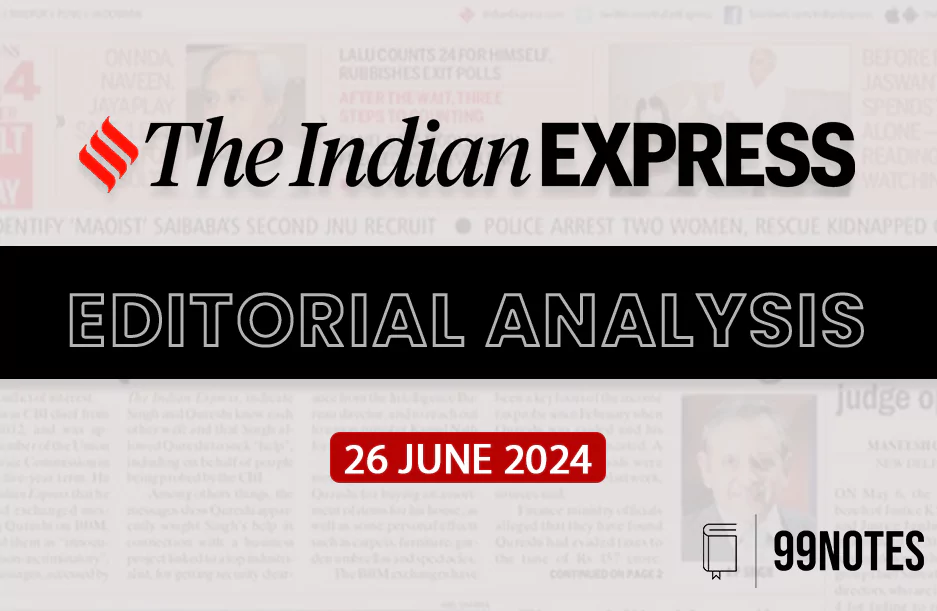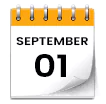25 June 2024 : Indian Express Editorial Analysis
1. One election, one phase
(Source: Indian Express; Section: The Ideas Page; Page: 09)
| Topic: GS2 – Polity |
| Context: |
|
Problems with Multi-Phase Elections:
- Recent elections, such as the seven-phase election held in extreme temperatures, have highlighted significant drawbacks.
- These extended elections have led to health hazards, including deaths due to heat.
- The prolonged process has drawn criticism from political parties, the media, and voters, with even the Chief Election Commissioner admitting that shorter elections are preferable.
Historical Context:
- Multi-phase elections were introduced to counter the widespread violence and use of muscle power prevalent during polling days in the past.
- The deployment of central armed police forces by T. N. Seshan in the mid-1990s aimed to ensure peaceful elections. However, the limited availability of paramilitary personnel required their rotation across phases, leading to the adoption of multi-phase elections, which were initially supported by political parties.
New Challenges in the Digital Age:
- Despite the initial success in maintaining peace, the rise of social media and digital communication has introduced new challenges.
- The spread of fake news, hate speech, and misinformation occurs rapidly, with severe consequences during multi-phase elections.
- The 2024 Lok Sabha elections, held over two-and-a-half months, saw high levels of communal rhetoric and the dissemination of disinformation, exacerbating the problems associated with prolonged polling periods.
The Impact of Social Media:
- The explosion of internet usage and social media platforms has transformed the political landscape.
- With millions of internet users, political content is widely shared, often without transparency regarding its sponsorship.
- This lack of accountability undermines the integrity of the electoral process and contributes to the spread of harmful content.
Proposals for Single-Phase Elections:
- Given the current challenges, there is a strong argument for reverting to single-phase elections.
- The Election Commission (EC) has implemented various measures to ensure peaceful elections, including vulnerability mapping, seizing illegal arms, and executing non-bailable warrants against criminals.
- These steps, along with the restoration of peace in previously troubled areas, support the feasibility of single-phase elections.
Legal Framework and Implementation:
- Existing laws provide a robust framework to address hate speech, cyber crimes, and election-related offenses.
- Sections of the Indian Penal Code (IPC) and the Representation of the People Act (RP) offer provisions for imprisonment and penalties for promoting enmity, defamation, and public mischief.
- Ensuring prompt and impartial enforcement of these laws is crucial for maintaining peace during elections.
Conclusion:
- A general election can be effectively conducted in a single phase, requiring about 33-35 days from notification to polling.
- This approach would reduce the duration of paramilitary deployment, lower campaign costs, and minimize disruptions to normal government functions.
- Most importantly, it would limit the window for spreading misinformation and hate speech, addressing concerns raised by leaders about prolonged elections. It is time to reconsider the logic of multi-phase elections in light of these factors.
| What are the Challenges Associated with ONOE? |
|
| PYQ: ‘Simultaneous election to the Lok Sabha and the State Assemblies will limit the amount of time and money spent in electioneering but it will reduce the government’s accountability to the people’ Discuss. (150 words/10m) (UPSC CSE (M) GS-2 2017) |
| Practice Question: In the context of Indian electoral practices, discuss the logic and implications of conducting multi-phase elections. What measures can be taken to ensure peaceful and fair elections in a single-phase format? (250 words/15 m) |
2. Navigating a multipolar world
(Source: Indian Express; Section: The Ideas Page; Page: 09)
| Topic: GS2 – International Relations |
| Context: |
|
Jaishankar’s Strategic Vision:
- S. Jaishankar has significantly influenced India’s foreign policy narrative. At the Bratislava Forum in 2022, he highlighted the need for Europe to recognize global problems beyond its own.
- This perspective resonated globally, including in Europe and the Global South, and emphasized India’s role as a neutral and non-aggressive power.
- However, with an 8.2% GDP growth rate and increasing integration into global trade regimes, India needs a narrative shift that balances political and economic priorities.
Continuity in South Asia:
- The new government’s inauguration saw the presence of leaders from South Asian countries, excluding Pakistan, signaling a focus on greater economic integration and geopolitical cohesion in the region.
- India’s neighbors, including Bangladesh, Bhutan, Nepal, Maldives, Sri Lanka, Mauritius, and Seychelles, indicate an agenda for enhanced regional collaboration.
Emphasis on the Global South:
- During India’s G20 presidency in 2023, there was significant focus on the Global South, marked by the inclusion of the African Union into the G20.
- Initiatives like the Dakshin Development and Knowledge Sharing Initiative Global South Centre for Excellence aim to foster knowledge-sharing and capacity-building, although actual achievements may take time to materialize.
Relations with Great Powers:
- India has maintained robust relationships with major powers, particularly the US and Russia, through mechanisms like the 2+2 ministerial dialogue.
- India is actively involved in multiple multilateral groupings such as G20, Quad, SCO, BRICS, I2U2, and the Indo-Pacific Economic Framework.
- Despite ongoing tensions with China, India has managed to avoid conflict, maintaining political engagement and continuing trade relations.
Economic Engagements and Trade Regimes:
- India’s participation in global trade regimes with major powers is evolving, with significant initiatives undertaken with middle powers like Australia and the UAE.
- Moving forward, India needs to transition its global conversation from political to economic, positioning itself as a trusted alternative to China.
- Efforts will focus on the Make in India initiative, enhancing supply chains, and increasing investments in manufacturing.
Expansion as a Services Exporter:
- India aims to expand its role as a services exporter, beyond IT services. The Telugu Desam Party’s involvement in building Amaravati as a modern tech capital highlights this focus.
- The country’s digital public infrastructure model is gaining acceptance globally, which, coupled with strategic trade agreements, could lead to significant economic benefits.
Diplomatic Shifts:
- Indian ambassadors are increasingly tasked with attracting investments, reflecting a shift in diplomatic priorities.
- The role of commercial attachés has gained prominence, underscoring the emphasis on economic diplomacy.
- India’s engagement with middle powers and peer group countries like Brazil, South Africa, Mexico, and Indonesia is expected to intensify, enhancing its global influence.
India’s Role in Global Stability:
- Amid global instability caused by events like the Covid-19 pandemic, the Russia-Ukraine war, and the Gaza conflict, middle powers are becoming more prominent.
- India, along with countries like Australia, South Korea, Saudi Arabia, Turkey, Singapore, and Germany, is asserting its influence, contributing to global stability.
Future Engagements and Goals:
- India’s active participation in international groupings and summits, such as the G7, SCO, and BRICS, reflects its commitment to economic progress and just global governance.
- By anchoring itself in the emerging multipolar world order, India aims to play a central role in maintaining global stability.
Conclusion:
- The new coalition government in India will likely ensure continuity in foreign policy, focusing on economic integration and regional collaboration.
- With strategic initiatives and a balanced approach to political and economic priorities, India is poised to enhance its global influence and contribute to a stable and multipolar world order.
| What are the Moral Aspects of India’s Foreign Policy? |
|
Panchsheel (Five Virtues): They were formally enunciated in the Agreement on Trade between the Tibet region of China and India signed on April 29, 1954 and later evolved to act as the basis of conduct of international relations globally. These Five Principles are:
Vasudhaiva Kutumbakam (The World is One Family): It is based on the concept of Sabka Saath, Sabka Vikas, Sabka Vishwas. In other words, India views the entire world community as a single large global family, where members live in harmony, work and grow together, and have trust in one another. Proactive and Impartial Assistance: India does not hesitate in promoting democracy wherever potential exists. This is done by proactively providing assistance in capacity building and strengthening the institutions of democracy, albeit with the explicit consent of the concerned Government. (Ex. Afghanistan). Global Problem Solving Approach: India advocates a global debate and global consensus on issues of global dimensions such as world trade regime, climate change, terrorism, intellectual property rights, global governance, health hazards. Under the Vaccine diplomacy initiative, India exported 60 million doses, half on commercial terms and 10 million as grants. |
| PYQ: “The long-sustained image of India as a leader of the oppressed and marginalised Nations has disappeared on account of its new found role in the emerging global order”. Elaborate. (250 words/15m) (UPSC CSE (M) GS-2 2019) |
| Practice Question: How can India balance political and economic priorities to achieve its goal of becoming a “leading power” in the evolving multipolar world order? (150 words/10 m) |





